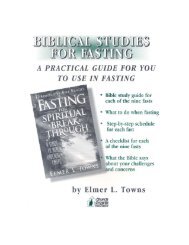PUTTING AN END TO WORSHIP WARS - Elmer Towns
PUTTING AN END TO WORSHIP WARS - Elmer Towns
PUTTING AN END TO WORSHIP WARS - Elmer Towns
- TAGS
- worship
- elmer
- towns
- elmertowns.com
Create successful ePaper yourself
Turn your PDF publications into a flip-book with our unique Google optimized e-Paper software.
Church. This includes ministries such as Sunday School, Vacation Bible School,<br />
Outreach Visitation, Nursing Home services, Children's Club Ministries, large evangelistic youth<br />
rallies, crusade evangelism, etc. Advocates of the cell group approach to ministry argue they<br />
accomplish more ministry through cells than would be accomplished through these other ministry<br />
options. Outside observers are not always convinced.<br />
One of the reasons people outside the Body Life Church remain skeptical is the tendency<br />
of many Body Life leaders to assume conclusions without verifying them with documentation.<br />
This movement was born out of an anti-institutionalism era and many leaders responded to the<br />
mood of the times by refusing to keep records of institutional growth. It is often difficult to<br />
document the growth of Body Life Churches because attendance is not counted. Also, church<br />
leaders describe their people as maturing faster than Christians in other churches, but again these<br />
claims are made without research support. Indeed, it may be very difficult to find a tool to<br />
measure Christian maturity and then demonstrate that Christians in one church mature faster than<br />
in others. Also, it would be difficult to identify all the causal factors that resulted in the faster<br />
maturing rate even if such a phenomena could be demonstrated.<br />
TAPPING IN<strong>TO</strong> THE STRENGTH OF THE BODY LIFE CHURCH<br />
If the strength of the Body Life Church is its cell group ministry, one of the ways other<br />
churches can tap into the strength of this worship style is to develop small group ministries as<br />
part of their broader ministry strategy. The primary analogy for the church in the New Testament<br />
is that of the body (1 Cor. 12:27, 28). Just as the body grows by the division of cells, so the<br />
church grows through the division of cells. One key to ongoing church growth is adding<br />
ministries, adding ministers, and adding places of ministry. Small group ministries enable<br />
churches to add new ministries at minimal costs to the church, develop new lay ministers<br />
engaged in using their gifts in significant ministry, and provide new places of ministry both<br />
within the body and the broader community.<br />
Various approaches to establishing small group ministries have adopted by different<br />
churches. Some cell groups are arranged loosely by age, i.e., twenties, thirties, etc. Other<br />
churches group people by marital and/or family status, i.e., single adults, parents of teens, etc.<br />
Other cell groups are arranged according to unique needs of group members, i.e., single parents,<br />
military wives, etc. In some regional churches, people are assigned to cell groups in the<br />
communities in which they live. Many churches adopt an open policy and end up with cell<br />
groups which may fit any of the above patterns.<br />
Cell groups are most effective when they are established for a purpose. Some groups<br />
begin as an evangelistic home Bible study. As group members are converted, the group becomes<br />
a discipleship group. Later, that group may be divided into several evangelistic groups, or the<br />
purpose of the group will change again. In many larger groups, cell groups are organized for a<br />
fellowship purpose. People are encouraged to get to know one another better in a small group<br />
setting. Teaching is another purpose around which cell groups commonly meet.
















